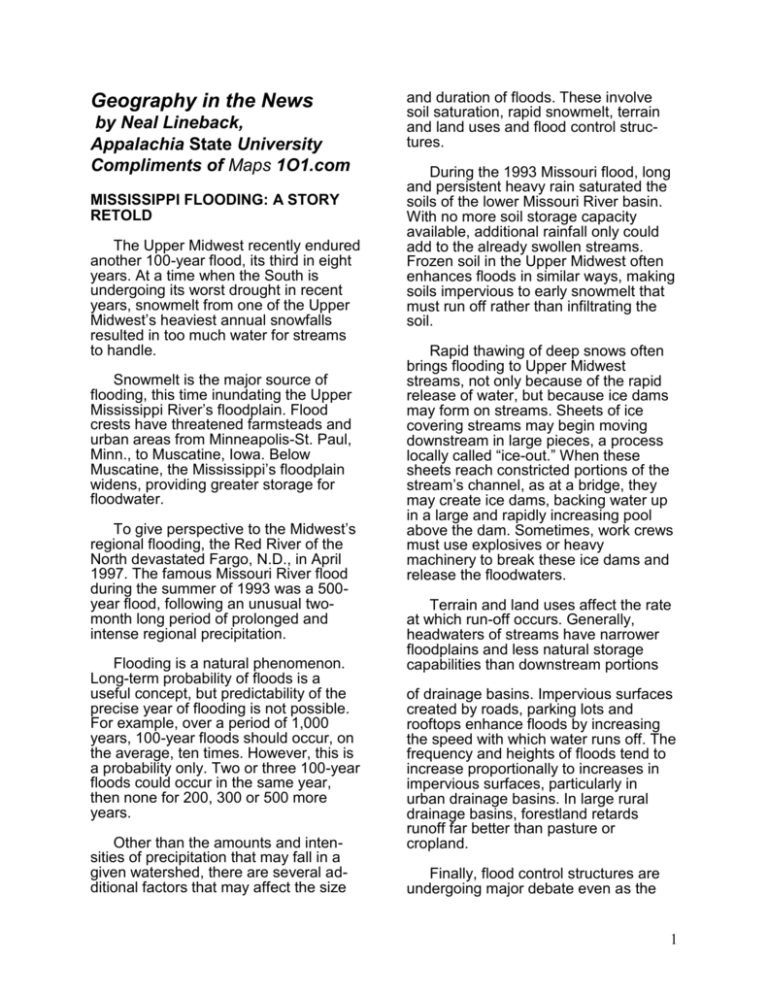Geography in the News - University of Missouri
advertisement

Geography in the News by Neal Lineback, Appalachia State University Compliments of Maps 1O1.com MISSISSIPPI FLOODING: A STORY RETOLD The Upper Midwest recently endured another 100-year flood, its third in eight years. At a time when the South is undergoing its worst drought in recent years, snowmelt from one of the Upper Midwest’s heaviest annual snowfalls resulted in too much water for streams to handle. Snowmelt is the major source of flooding, this time inundating the Upper Mississippi River’s floodplain. Flood crests have threatened farmsteads and urban areas from Minneapolis-St. Paul, Minn., to Muscatine, Iowa. Below Muscatine, the Mississippi’s floodplain widens, providing greater storage for floodwater. To give perspective to the Midwest’s regional flooding, the Red River of the North devastated Fargo, N.D., in April 1997. The famous Missouri River flood during the summer of 1993 was a 500year flood, following an unusual twomonth long period of prolonged and intense regional precipitation. Flooding is a natural phenomenon. Long-term probability of floods is a useful concept, but predictability of the precise year of flooding is not possible. For example, over a period of 1,000 years, 100-year floods should occur, on the average, ten times. However, this is a probability only. Two or three 100-year floods could occur in the same year, then none for 200, 300 or 500 more years. Other than the amounts and intensities of precipitation that may fall in a given watershed, there are several additional factors that may affect the size and duration of floods. These involve soil saturation, rapid snowmelt, terrain and land uses and flood control structures. During the 1993 Missouri flood, long and persistent heavy rain saturated the soils of the lower Missouri River basin. With no more soil storage capacity available, additional rainfall only could add to the already swollen streams. Frozen soil in the Upper Midwest often enhances floods in similar ways, making soils impervious to early snowmelt that must run off rather than infiltrating the soil. Rapid thawing of deep snows often brings flooding to Upper Midwest streams, not only because of the rapid release of water, but because ice dams may form on streams. Sheets of ice covering streams may begin moving downstream in large pieces, a process locally called “ice-out.” When these sheets reach constricted portions of the stream’s channel, as at a bridge, they may create ice dams, backing water up in a large and rapidly increasing pool above the dam. Sometimes, work crews must use explosives or heavy machinery to break these ice dams and release the floodwaters. Terrain and land uses affect the rate at which run-off occurs. Generally, headwaters of streams have narrower floodplains and less natural storage capabilities than downstream portions of drainage basins. Impervious surfaces created by roads, parking lots and rooftops enhance floods by increasing the speed with which water runs off. The frequency and heights of floods tend to increase proportionally to increases in impervious surfaces, particularly in urban drainage basins. In large rural drainage basins, forestland retards runoff far better than pasture or cropland. Finally, flood control structures are undergoing major debate even as the 1 Mississippi endures its recent flooding. Artificial levees built along streams’ floodplains may help keep rising floodwaters from covering parts of the floodplain. These levees, however, remove the natural floodwater storage capacity of the floodplain itself Of particular concern are levees built to protect only crops. When levees are built on both sides of a stream, the river’s natural course may become “corseted,” or constricted. This creates higher water above the constriction than would occur under more natural stream channel and open floodplain conditions. storage system—carries a periodic price. Whether to build permanent flood control structures continues to be debated, as in Davenport. If flood frequency is increasing, however, lessons must be learned from every flood. And that is geography in the news. The Author is professor of geography at Appalachia State University. This column is provie3d to Perspective courtesy of www.Maps101.com Some Mississippi towns and cities are giving increased attention to a more passive approach to urban flooding than building high levees. Davenport, Iowa, for example, has chosen not to build large permanent levees that would protect the downtown area. Coveting the more natural relationship between the city and the Mississippi River, Davenport uses temporary levees built only when flooding threatens. These temporary sandbag structures are not as substantial or protective as earthen levees, but they help preserve the scenic relationship with the river when they are removed after a flood. Under these laissez-faire conditions, businesses may be encouraged to establish their own protection from the rising waters, rather than relying upon governmental protection. Some recent urban buildings have been constructed with decorative “seawalls,” in order to protect them from 100- and 500-year floods. Such walls may be reinforced brick that may be sealed off to protect the building from rising water. The recent Mississippi floods have sorely tested flood control structures along 50 miles (805 km.) of its upper floodplain. Construction of building on floodplains—nature’s natural floodwater 2










